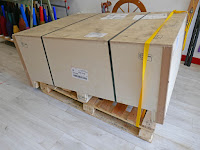I have just taken delivery of a new loom - but it's all in pieces! Scandinavian flatpack.....
The loom is a Toika from Finland and I chose the 16 shaft Llisa model with computer dobby. It arrived beautifully packed in a large wooden pallet box which for some reason had been put on top of a standard pallet which was too small to properly hold the box. However with the aid of some extra strapping and a bit of muscle power from my neighbour we managed to get the box across the gravel driveway and into the loomshed.
I had read somewhere online that it needed a crowbar to open the box, so I was prepared for that. But there were two steel straps tensioned around the crate. Fortunately my side-snip wire cutters were up to the job and I managed to chew through the straps and set to work with the crowbar.
Inside, all the pieces were well wrapped, anchored and secured so it took a good hour or so just to unpack the box. At the end of that there was an enormous pile of polystyrene and cardboard, but thankfully that same obliging neighbour was making a trip to the recycling centre.......
The next step was to try and sort out all the pieces. This was when I realised that there were just two pages of diagrams with captions in English and that the diagrams were for the non-computer version of the loom. Not all the parts matched up.
Where to start....... I decided that assembling the bench stool would be a good place as I managed to figure out which pieces were needed for that. If I had somewhere to sit, my brain might function better!
Having bought a fair amount of Ikea flatpack over the years, I recognised which pieces I needed and set to work - concealed bolts and hex-key. The stool is height adjustable but I didn't put the locking bolts in place as I wanted to wait until I could sit at the loom to check the height I need.
After the stool was made I decided to call it a day, take the booklet (in Finnish) home with me and try and figure it all out.









Comments
Post a Comment